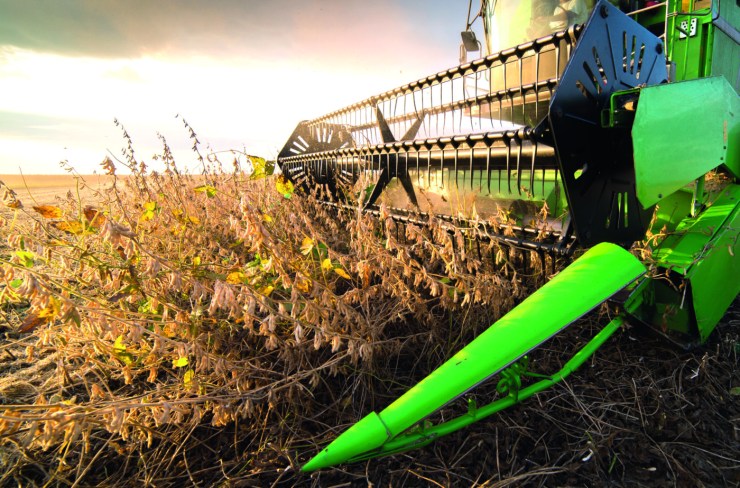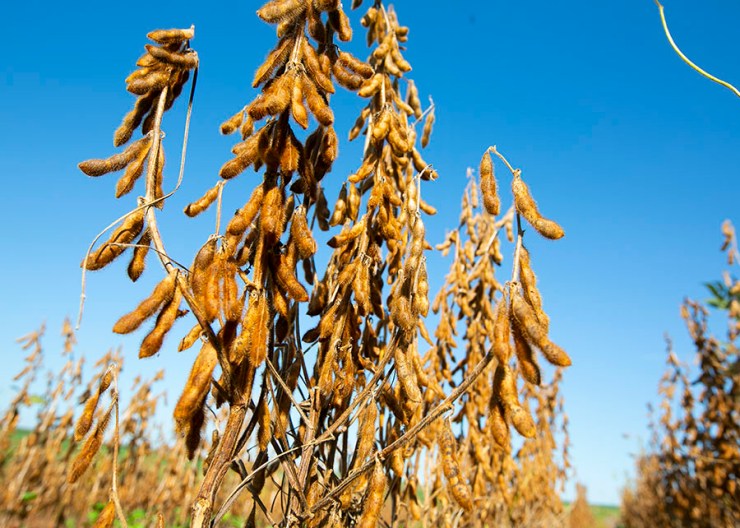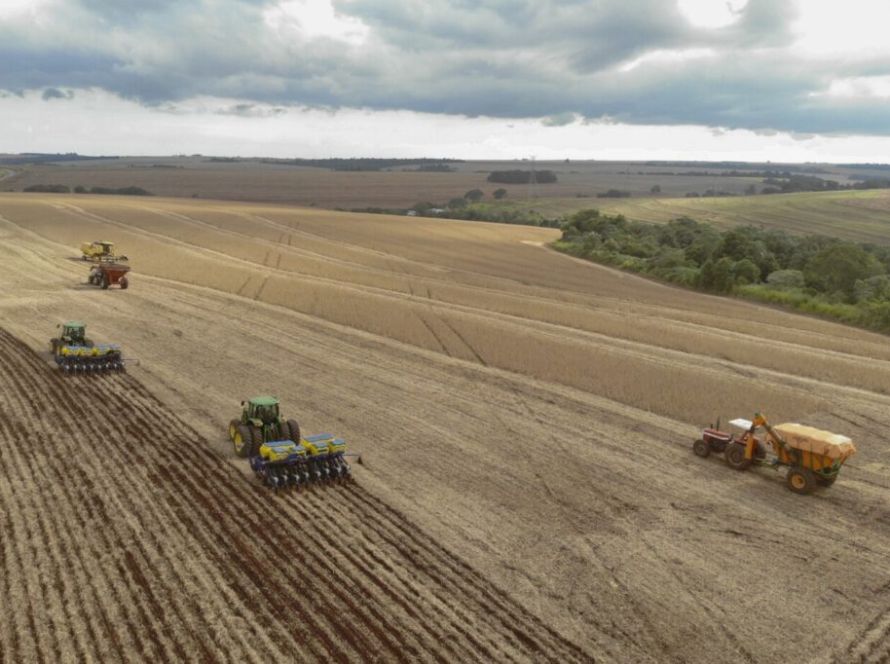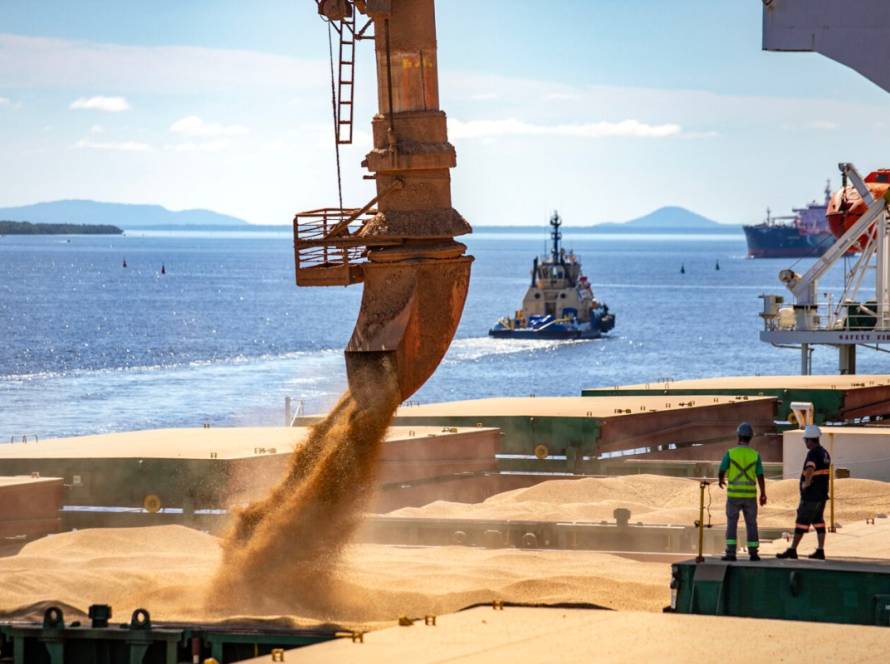The flagship of national agricultural production, soybeans have consolidated Brazil as a global leader in the production and export of the grain. Having been cultivated in the country for over a century, the crop began commercially in Rio Grande do Sul and underwent significant transformations until it reached the prominent position it occupies today in global agribusiness.
Embrapa Soja highlighted this trajectory during the Show Rural Coopavel 2025, held between February 10 and 14, in Cascavel (PR), through a timeline with the main cultivars developed over the decades. The exhibition emphasized the fundamental role of genetic improvement in adapting soybeans to the tropical conditions of Brazil, a decisive factor for the success of the crop in the country.

General Manager of Embrapa Soja, Alexandre Nepomuceno: “Soybeans are the lever of agribusiness and the Brazilian economy, and this was possible thanks to the scientists, technicians and producers who did an excellent job” – Photo: Disclosure/Embrapa Soja
Soybeans were introduced to Brazil in 1914 for testing purposes, and commercial cultivation of the grain began in Santa Rosa (RS) in 1924. Before that, in the 19th century, there was an attempt to plant soybeans in Bahia, using seeds brought from the United States. However, the materials available at the time were adapted to temperate and subtropical climates, resulting in an unsuccessful experiment. Only with the advancement of scientific research and the efforts of institutions such as Embrapa did soybeans undergo an intense process of tropicalization, allowing their expansion to other regions of the country. However, soybeans only gained economic importance in the 1960s, when cultivation grew rapidly.
Although it was domesticated around four thousand years ago on the East Coast of Asia, the soybean cultivated today presents significant differences in relation to its Chinese ancestor. “The soybean sown today has the genetic constitution of China, but it is different in appearance and in morphological and production characteristics”, explains the general manager of Embrapa Soja, Alexandre Nepomuceno.
Until the end of the 1970s, commercial soybean plantations in the world were restricted to temperate and subtropical climates, at latitudes close to or above 30º. In Brazil, producers used cultivars imported from the United States, adapted only to the southern region. This limitation was overcome with research by Embrapa, which developed varieties suitable for tropical conditions, allowing the expansion of the cultivation of the oilseed throughout the country.
Since the experimental introduction of soybeans in Brazil, several cultivars have been developed to increase productivity, adaptability and disease resistance. Embrapa Soja has played a fundamental role in this advancement, developing around 440 cultivars over the last 50 years. The institution invests in both conventional varieties that are resistant to pests and diseases and in genetically modified cultivars that are adapted to the use of herbicides and insect control.
Genetic advancement and crop adaptation were key to Brazil becoming a benchmark in soybean production. Today, the country not only meets domestic demand, but also plays a strategic role in the global supply of grains, reinforcing its importance in global food security. “Soybeans are the lever of agribusiness and the Brazilian economy, and this was possible thanks to the scientists, technicians and producers who did an excellent job,” highlights Nepomuceno.
Soybean Timeline

Agricultural engineer, PhD in Plant Science and Technology Transfer Analyst at Embrapa Soja, Rogério de Sá Borges: “With the expansion of cultivated areas, new problems appear, requiring research to always be one step ahead to anticipate and prevent significant impacts in the field” – Photo: Jaqueline Galvão/OP Rural
Over the decades, several cultivars have been launched, but some have become iconic due to their permanence in the market and impact on agricultural productivity. At Embrapa's exhibition at the Show Rural Coopavel 2025, different varieties of soybeans were presented, including wild soybeans, which are perennial, and Glycine soybeans, a closer ancestor of cultivated soybeans, with an annual cycle. In addition, several cultivars of Glycine max (cultivated soybeans) were also on display.
Among the cultivars on display, the highlight is Amarela Comum, also known as Amarela do Rio Grande, introduced from the United States. This variety was cultivated in Brazil between the 1920s and 1960s, and was essential for the expansion of soybean farming in the country.
Another cultivar in demonstration was Pelicano, introduced in the 1950s and cultivated until the mid-1960s. In the same decade, Bragg became one of the main cultivars used in the southern states and in São Paulo.
The Davis cultivar was also introduced, which stood out for its resistance to frogeye leaf spot and brown rot. According to the agronomist, PhD in Plant Science and Technology Transfer Analyst at Embrapa Soja, Rogério de Sá Borges, Davis marked a new phase in the genetic improvement of the crop. “From Davis onwards, there was a slightly greater concern about diseases. Launched after Bragg, and already with some sanitary improvements, this cultivar was more tolerant to diseases,” he explained.
In 1966, the first genuinely Brazilian soybean cultivar with commercial importance was launched: Santa Rosa, considered one of the most important in history. And in the 1970s, the Paraná cultivar emerged, which stood out for its plant architecture and precocity for the time.
With the creation of Embrapa in 1975, a genetic improvement program was initiated at the institution. In the early 1980s, Embrapa launched its first proprietary cultivar, BR-16, developed from crosses carried out in the experimental field of Londrina (PR). With genealogy associated with the Davis cultivar, BR-16 was very successful until the 2000s, due to its resistance to brown stem rot and stem canker, in addition to its wide adaptation. Its planting was recommended for Rio Grande do Sul, Santa Catarina, Paraná, and even Minas Gerais, contributing to the expansion of soybeans in the country.
 In the 1990s, the focus was on the search for physiological seed quality, disease resistance and earliness. In this context, the cultivars Embrapa 48 and BRS 133 stood out, resistant to bacterial pustule, frogeye spot and stem canker. Identified in Brazil in 1989, stem canker caused losses of up to 100%, forcing the withdrawal of susceptible cultivars from the market. “It was necessary to completely reconvert the available varieties, since practically all of them were susceptible to the disease. Since there were already structured breeding programs, the response was quick. This advance was essential to ensure that soybean cultivation would not cease in Brazil. Today, practically all varieties are resistant to stem canker,” said Borges, emphasizing that after that, the development of new varieties was based on specific habits.
In the 1990s, the focus was on the search for physiological seed quality, disease resistance and earliness. In this context, the cultivars Embrapa 48 and BRS 133 stood out, resistant to bacterial pustule, frogeye spot and stem canker. Identified in Brazil in 1989, stem canker caused losses of up to 100%, forcing the withdrawal of susceptible cultivars from the market. “It was necessary to completely reconvert the available varieties, since practically all of them were susceptible to the disease. Since there were already structured breeding programs, the response was quick. This advance was essential to ensure that soybean cultivation would not cease in Brazil. Today, practically all varieties are resistant to stem canker,” said Borges, emphasizing that after that, the development of new varieties was based on specific habits.
From the 2000s onwards, a new generation of cultivars began, marked by the introduction of herbicide-resistant transgenic soybeans and the search for shorter cycles and plant size that would make the sowing of off-season corn viable. There were also advances in the nutritional quality of the cultivars.
From this phase, the highlights are BRS 232, with resistance to root-knot nematodes, high protein content and high production potential, and BRS 284, which introduced the novelty of indeterminate growth. With its distinctive architecture and wide adaptation, BRS 284 was recommended for states such as Santa Catarina, Paraná, São Paulo, Mato Grosso do Sul, Mato Grosso, Goiás and Minas Gerais, and is still cultivated.
Before the release of transgenic soybeans in Brazil, materials of indeterminate use were illegally introduced, mainly from Argentina. This type of soybean is less sensitive to photoperiod variation, allowing planting to occur earlier. “The cultivars planted until then, with determinate habit, had to be planted between the end of October and the beginning of November. With the indeterminate varieties, it was possible to bring forward sowing, and today, for example, in the Cascavel region (PR), soybeans can already be planted in September”, explained the Technology Transfer analyst at Embrapa Soja.
 According to Borges, with the advance of the second corn crop, the demand for earlier cultivars increased. “Planting soybeans earlier made it possible to harvest earlier, ensuring that corn was sown before winter, reducing the risk of losses and increasing productivity. This movement led practically all companies in the sector, especially in the South, to adopt cultivars with indeterminate habits,” said the Ph.D. in Plant Science.
According to Borges, with the advance of the second corn crop, the demand for earlier cultivars increased. “Planting soybeans earlier made it possible to harvest earlier, ensuring that corn was sown before winter, reducing the risk of losses and increasing productivity. This movement led practically all companies in the sector, especially in the South, to adopt cultivars with indeterminate habits,” said the Ph.D. in Plant Science.
In the 2010s, genetic improvement advanced with the introduction of cultivars that were more resistant to Asian rust, tolerant to stink bugs and had an early cycle. In addition, the use of indeterminate growth cultivars was consolidated and the arrival of the second generation of transgenics, which combined resistance to herbicides and tolerance to caterpillars.
In this phase, Embrapa exhibited the conventional cultivar BRS 511, with Shield® technology for resistance to Asian rust, and the transgenic BRS 1003IPRO, which, in addition to resistance to herbicides and caterpillars, brought Block® technology for tolerance to bedbugs.
In the 2020s, BRS 1064IPRO stood out as a second-generation GM cultivar, widely adapted to the southern, southeastern and central-western states. In addition to its high production potential, it presents production stability, allowing early sowing and fitting into the second crop succession and rotation system. The cultivar also has moderate resistance to the root-knot nematode (M. javanica) and resistance to race 3 of the cyst nematode, an indeterminate growth type and high production potential.
Currently, soybeans have evolved into the third generation of transgenic crops, with cultivars tolerant to a greater number of herbicides, such as glyphosate, dicamba, 2,4-D and glufosinate ammonium. “This has expanded the options for managing weeds in the crop and increased protection against caterpillars,” Borges highlighted.
Major advances in soybeans
The main objective of soybean genetic improvement programs is to increase productivity, ensuring the financial sustainability of the producer. Furthermore, resistance to diseases such as stem canker was a major advance for the continuity of the crop in the country. “Without a genetic improvement program, this would not have been possible. If Brazil had depended on imports at the time when stem canker devastated crops, soybean production in the country could have become unviable. Consequently, we would not be the largest producer in the world and would not have the economic relevance that we have today, generating thousands of jobs. That is why research is essential”, emphasizes the PhD in Plant Science.
Adapted cultivars boost soybean productivity
 In the 1950s and 1960s, the first soybean cultivars in Brazil produced around 1,500 kilos per hectare. Today, the national average has reached 3,500 kilos, with varieties that can reach between 5,000 and 6,000 kilos per hectare. This advance was possible thanks to scientific research and genetic improvement, both by Embrapa and private companies. In addition to the increase in productivity, the adaptation of the crop to different regions was what allowed the expansion of soybeans into the Cerrado.
In the 1950s and 1960s, the first soybean cultivars in Brazil produced around 1,500 kilos per hectare. Today, the national average has reached 3,500 kilos, with varieties that can reach between 5,000 and 6,000 kilos per hectare. This advance was possible thanks to scientific research and genetic improvement, both by Embrapa and private companies. In addition to the increase in productivity, the adaptation of the crop to different regions was what allowed the expansion of soybeans into the Cerrado.
In Mato Grosso, the country’s largest producer, cultivars developed for the South show low adaptability. “It is essential that genetic improvement programs select materials with characteristics specific to each region,” argues the agricultural engineer. This process, known as soybean tropicalization, has made production possible in areas previously considered unviable. “Originally, soybeans were grown at latitudes close to 30ºC. Today, production is even in Roraima, close to the equator,” he adds.
Current challenges
Currently, one of the main challenges for soybean farming is adverse weather conditions. Losses due to drought and water stress are increasingly significant, requiring rapid responses from research, with the development of cultivars that are more tolerant to drought and resistant to high temperatures. “Producers have great expectations for cultivars with these characteristics. Genetic improvement continues to advance, whether through traditional methods, transgenics or gene editing, to meet these demands,” the specialist highlighted.
 In addition to climate adaptation, another challenge is the quality of the seed and soybeans produced. In the United States, there is a growing movement to develop grains with a high oleic acid content and low linoleic acid content, resulting in a better quality oil. This evolution is also linked to the use of soybeans for biofuels, including jet fuel. “These changes involve an adaptation in the technological profile of the grain. If we do not follow this trend, we run the risk of Brazilian soybeans losing competitiveness in the global market, becoming a second-class product while other countries lead the production of grains with higher added value”, warns Borges. According to him, Brazil is already anticipating this movement, developing materials with differentiated oil and protein profiles, essential to maintaining its position in the international market.
In addition to climate adaptation, another challenge is the quality of the seed and soybeans produced. In the United States, there is a growing movement to develop grains with a high oleic acid content and low linoleic acid content, resulting in a better quality oil. This evolution is also linked to the use of soybeans for biofuels, including jet fuel. “These changes involve an adaptation in the technological profile of the grain. If we do not follow this trend, we run the risk of Brazilian soybeans losing competitiveness in the global market, becoming a second-class product while other countries lead the production of grains with higher added value”, warns Borges. According to him, Brazil is already anticipating this movement, developing materials with differentiated oil and protein profiles, essential to maintaining its position in the international market.
In addition, in recent years, soybean crops have been facing new diseases and pests. Asian rust, for example, was first identified in Brazil in the 2001/2002 harvest and is now one of the main threats to production. Another growing concern is nematodes, which spread rapidly and challenge producers on a daily basis. “Research needs to offer solutions in both genetic improvement and management. The industry seeks alternatives with new products, but challenges arise continuously. As the cultivated area expands, new problems appear, requiring research to always be one step ahead to anticipate and prevent significant impacts in the field,” Borges stressed.
Importance of the sanitary gap
To reduce the incidence of Asian rust, a sanitary break was established, a period without soybean cultivation to avoid the so-called 'green bridge', which favors the survival of pests and diseases. "Phytopathologists have identified that soybean rust does not survive for long in crop residues. With three to four months without soybeans, the disease inoculum is significantly reduced. Therefore, even if the rust reappears, it takes longer to spread, allowing less need for fungicide applications", explains the professional.
Excessive use of pesticides accelerates the selection of resistant individuals within the fungal population. “Each application can select organisms that survive the product, making control less efficient over time. Therefore, it is essential to combine appropriate management with chemical control, preserving the effectiveness of the tools available on the market,” adds Borges.
Structural refuge strategy
In transgenics, it is recommended to sow 20% in the area with cultivars without the BT gene, a strategy known as structural refuge. “This allows the reproduction of susceptible caterpillars, which cross with BT-resistant individuals, delaying the development of resistant 100% populations,” explains Borges.
 He warns of the risk of this technology losing its effectiveness, as has already occurred with BT corn varieties. “There will always be resistant individuals that survive the consumption of BT soybeans. If the entire crop is transgenic, these resistant individuals will cross with each other, generating descendants that are completely immune to the technology. The refuge maintains a susceptible population in the area, extending the useful life of the technology,” emphasizes the Ph.D. in Plant Science.
He warns of the risk of this technology losing its effectiveness, as has already occurred with BT corn varieties. “There will always be resistant individuals that survive the consumption of BT soybeans. If the entire crop is transgenic, these resistant individuals will cross with each other, generating descendants that are completely immune to the technology. The refuge maintains a susceptible population in the area, extending the useful life of the technology,” emphasizes the Ph.D. in Plant Science.
Destination of soybean production
Most of the soybeans produced in Brazil are used for animal feed and the biofuel industry, a sector that has been gaining market share. “The segment of conventional, non-GMO soybeans for human consumption is still small, but Embrapa maintains an active genetic improvement program,” says Borges. However, GMO commodities dominate the market, especially in the production of animal feed.
Collection with 65 thousand types of soybeans
The seeds of the 16 soybean cultivars on display at the Rural Show are part of the Active Germplasm Bank (BAG), a collection of approximately 65,000 types of soybeans introduced from the United States and other countries in Africa, Europe, Asia, the Middle East and Oceania. The BAG, maintained by Embrapa, is responsible for storing the genetic variability of soybeans. The more different and characterized accessions, the better the use in breeding programs for the development of new varieties.
Access to the digital edition of Bovinos, Grãos & Máquinas is free. To read the full version online, simply click here. Happy reading!





